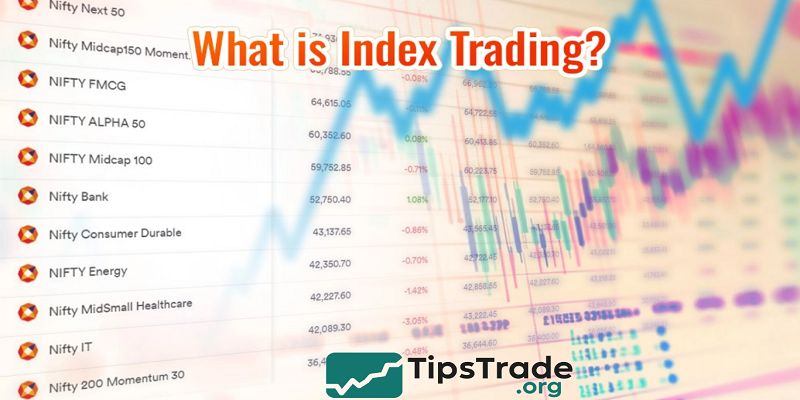Index investing is a passive investment strategy aimed at matching the performance of a market index. Investors buy funds that replicate the index, offering low costs, broad diversification, and steady returns over the long term. This approach simplifies investing by reducing the need for active management and individual stock selection. Visit tipstrade.org and check out the article below for further information.
What Is Index Investing?

- Index investing is a passive investment strategy that aims to replicate the performance of a market index.
- Instead of picking individual stocks, investors buy into an index fund or exchange-traded fund (ETF) that tracks a benchmark like the S&P 500, Nasdaq-100, or FTSE All-World Index.
- For example, the Vanguard S&P 500 ETF (VOO) holds shares of 500 leading U.S. companies, including Apple, Microsoft, and Amazon.
- When the S&P 500 rises or falls, the ETF’s value moves in the same direction.
- This approach is called “passive” because there’s no constant trading or forecasting involved—the fund simply follows the index.
- Over time, this low-cost, rules-based approach compounds quietly, often outperforming active managers who try to outsmart the market.
A Brief History of Index Investing
- The concept of index investing began in the 1970s with John C. Bogle, founder of Vanguard.
- Bogle launched the first index mutual fund—the Vanguard 500 Index Fund—in 1976.
- Critics called it “Bogle’s folly,” but time proved them wrong.
- Today, global assets in index funds and ETFs exceed $15 trillion, according to the Investment Company Institute (2024).
- Major providers include Vanguard, BlackRock’s iShares, and State Street’s SPDR.
- The rise of fintech platforms and robot – advisors (like Betterment and Wealthfront) has made index investing accessible to anyone with a smartphone and $50 to start.
- It’s no longer a strategy for professionals—it’s the foundation of modern wealth building.
See more:
- Important Economic Indexes Every Trader Needs To Know
- How To Buy Stocks in 4 Steps: Quick-Start Guide for Beginners
- Long-Term Stock Investing: Benefits and Key Principles to Understand
- Day Trading Stocks: Benefits, Risks, and Effective Investing Strategies
Why Many Investors Prefer Index Investing

Low Costs Mean Higher Returns Over Time
- The biggest advantage of index investing is its ultra-low cost. Active mutual funds often charge 1%–2% annually in management fees.
- Index funds, in contrast, typically charge 0.03%–0.10%.
- This difference might seem small, but over 30 years, it can cost an investor hundreds of thousands of dollars.
- According to Vanguard, a $100,000 portfolio growing at 7% annually with a 1% annual fee will be worth about $574,000 after 30 years—versus $761,000 with only a 0.05% index fund fee.
- Low fees compound in your favor. That’s why even Warren Buffett, one of the world’s most successful active investors, recommends index funds for most people.
Diversification Made Easy
- Diversification—owning many investments to reduce risk—is built into index funds.
- A single S&P 500 fund gives you exposure to 500 companies across multiple sectors.
- Global index funds go even further, covering thousands of stocks across continents.
- This diversification cushions you from the failure of any one company or industry.
- Instead of betting on winners and losers, you own the whole market. It’s a simple but powerful way to manage risk.
Proven Long-Term Performance
Decades of research back index investing’s performance. The SPIVA (Scorecard) by S&P Dow Jones Indices consistently shows that the majority of active funds underperform their benchmarks:
- Over 90% of U.S. large-cap managers underperformed the S&P 500 over 15 years.
- Similar trends exist across Europe, Canada, and emerging markets.
Index investing doesn’t promise spectacular short-term returns—it delivers market returns with remarkable consistency. For long-term investors, that consistency is golden.
How to Get Started with Index Investing

Choose the Right Index Fund or ETF
Start by deciding which index you want to track. The right choice depends on your goals and risk tolerance:
| Index | Description | Common ETFs |
| S&P 500 | 500 largest U.S. companies | VOO, IVV, SPY |
| Total U.S. Market | All U.S. stocks | VTI, SCHB |
| International Markets | Developed & emerging markets | VXUS, IXUS |
| Bond Index | Government & corporate bonds | BND, AGG |
When choosing a fund, focus on:
- Expense ratio (lower is better)
- Tracking error (how closely it follows the index)
- Fund size & liquidity
Avoid exotic or leveraged ETFs unless you fully understand their risks.
Set Your Asset Allocation
Your asset allocation—how you divide money between stocks, bonds, and cash—determines your portfolio’s risk and return.
A common rule of thumb:
- Young investors (20s–30s) → 80–90% in stock index funds, 10–20% in bonds.
- Middle-aged investors (40s–50s) → 60–70% stocks, 30–40% bonds.
- Retirees → 40–50% stocks, 50–60% bonds or income ETFs.
The key is to pick a mix you can stick with during market downturns.
Automate and Stay Consistent
- The magic of index investing lies in discipline.
- Set up automatic contributions—monthly or quarterly—and invest consistently, regardless of market conditions.
- This method, known as dollar-cost averaging (DCA), smooths out volatility.
- You buy more shares when prices drop and fewer when they rise, lowering your average cost over time.
- Many brokers and robo-advisors automate this process for you.
- Once set, you can essentially “set it and forget it,” letting compounding do its work.
Rebalance Your Portfolio Regularly
- Over time, market movements can shift your allocation. For instance, if stocks soar, your 70/30 portfolio might become 80/20.
- Rebalancing—selling high-performing assets and buying laggards—restores your original mix and maintains risk levels.
- Most experts recommend rebalancing once or twice per year. Many platforms like Vanguard and Fidelity offer automatic rebalancing tools.
Be Aware of Taxes and Efficiency
- Index funds are tax-efficient because they have low turnover. Fewer trades mean fewer taxable capital gains.
- If you’re investing in taxable accounts, consider holding stock index funds (which are tax-efficient) and placing bonds in tax-advantaged accounts like IRAs or 401(k)s.
- ETFs are generally more tax-efficient than mutual funds because of their “in-kind” creation and redemption mechanism, which minimizes taxable distributions.
Common Misconceptions and Risks
Index Investing Is Risk-Free
- Index investing reduces some risks but not all. Market risk—the chance that the entire market declines—still exists.
- In 2008, global stock markets fell more than 40%, and index investors experienced similar losses.
- Index investing requires patience and emotional discipline.
Index Funds Always Outperform
- While index funds outperform most active funds, there are periods when active managers can win—especially in niche markets or small-cap segments.
- However, predicting when that will happen is nearly impossible.
- Most investors are better off sticking to index strategies for their core portfolio, perhaps complementing with a few active or thematic funds for diversification.
Concentration Risk in Market-Cap Indexes
- Market-cap-weighted indexes give more weight to larger companies.
- For example, the top 10 stocks in the S&P 500 make up over 30% of its total value.
- That means when tech giants like Apple or Microsoft move, the entire index moves with them.
- To mitigate this, investors can explore equal-weighted or factor-based ETFs that diversify more evenly.
Index Investing in Global Markets

U.S. Markets
- The U.S. remains the world’s largest and most liquid market, home to the S&P 500, Nasdaq 100, and Russell 2000 indexes.
- U.S.-based index funds like VTI or SPY are among the most traded and trusted worldwide.
They provide strong transparency, liquidity, and low fees—ideal for global investors.
International and Emerging Markets
Global diversification helps reduce country-specific risks. International index funds track markets in Europe, Asia, and emerging economies.
Examples include:
- VXUS (Vanguard Total International Stock ETF)
- EEM (iShares MSCI Emerging Markets ETF)
Adding global exposure can smooth your portfolio’s performance and capture growth in developing regions.
Conclusion
Index investing is a simple and cost-effective way to gain broad market exposure and achieve steady long-term growth. By following a market index, investors benefit from diversification, lower fees, and reduced risks compared to active investing. This strategy is ideal for those seeking consistent returns without the need for frequent trading or stock picking. Overall, index investing offers a disciplined approach that aligns well with long-term financial goals.
>>See more:

